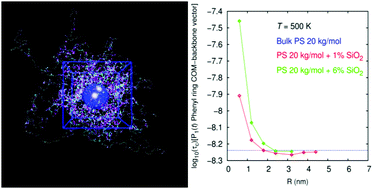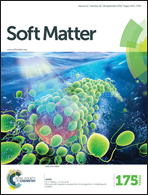Multiscale simulations of PS–SiO2 nanocomposites: from melt to glassy state
Abstract
The interaction energetics, molecular packing, entanglement network properties, segmental dynamics, and elastic constants of atactic polystyrene–amorphous silica nanocomposites in the molten and the glassy state are studied via molecular simulations using two interconnected levels of representation: (a) a coarse-grained one, wherein each polystyrene repeat unit is mapped onto a single “superatom” and the silica nanoparticle is viewed as a solid sphere. Equilibration at all length scales at this level is achieved via connectivity-altering Monte Carlo simulations. (b) A united-atom (UA) level, wherein the polymer chains are represented in terms of a united-atom forcefield and the silica nanoparticle is represented in terms of a simplified, fully atomistic model. Initial configurations for UA molecular dynamics (MD) simulations are obtained by reverse mapping well-equilibrated coarse-grained configurations. By analysing microcanonical UA MD trajectories, the polymer density profile is studied and the polymer is found to exhibit layering in the vicinity of the nanoparticle surface. An estimate of the enthalpy of mixing between polymer and nanoparticles, derived from the UA simulations, compares favourably against available experimental values. The dynamical behaviour of polystyrene (in neat and filled melt systems) is characterized in terms of bond orientation and dihedral angle time autocorrelation functions. At low concentration in the molten polymer matrix, silica nanoparticles are found to cause a slight deceleration of the segmental dynamics close to their surface compared to the bulk polymer. Well-equilibrated coarse-grained long-chain configurations are reduced to entanglement networks via topological analysis with the CReTA algorithm, yielding a slightly lower density of entanglements in the filled than in the neat systems. UA melt configurations are glassified by MD cooling. The elastic moduli of the resulting glassy nanocomposites are computed through an analysis of strain fluctuations in the undeformed state and through explicit mechanical deformation by MD, showing a stiffening of the polymer in the presence of nanoparticles. UA simulation results for the elastic constants are compared to continuum micromechanical calculations invoked in homogenization models of the overall mechanical behaviour of heterogeneous materials. They can be interpreted in terms of the presence of an “interphase” of approximate thickness 2 nm around the nanoparticles, with elastic constants intermediate between those of the filler and the matrix.


 Please wait while we load your content...
Please wait while we load your content...